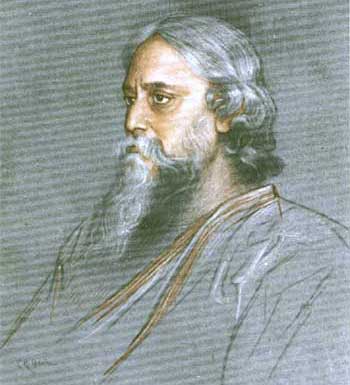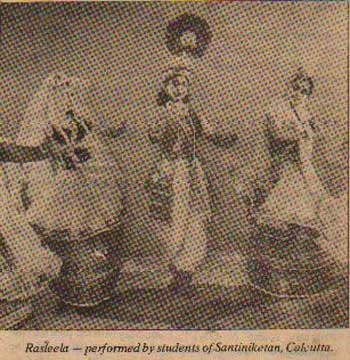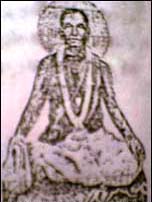Rabindranath Tagore (রবীন্দ্রনাথ ঠাকুর), the Nobel laureate poet, writer, philosopher is probably the most prominent figure in the cultural world of Indian subcontinent and also was the greatest patron of the Manipuri dance and culture. It was him who popularized the Manipuri style of dance with its high zenith among the people of the world. He deserves the honorable place in the style and regarded as the “Pioneer of Manipuri dance and culture”.
From Tagore’s writings and other historical accounts we can learn a little bit about his visit in Sylhet (in present day Bangladesh) . It was 1919 when the historical event had taken place. In November 6th, Rabindranath had a visit in the Bishnupriya Manipuri (বিষ্ণুপ্রিয়া মণিপুরী) village of Machimpur(মাছিমপুর), a remote village not far away from the town situated on the bank of the river Surma. He was given a warm reception there from the Bishnupriya Manipuri people. He was so impressed after seeing a dance composition, the Goshtha Lila presented by the Bishnupriya Manipuri women. After seeing the demonstrations Rabindranath introduced himself to the people and wanted to be informed more about their dance and culture. He also met that time exile superintendent Mr Tanu Singha and looked for a Manipuri Oja (dance teacher) who was capable of communicating in Bangla. Mr Tanu Singha introduced the poet with great Guru Nileshwar Mukharjee (গুরু নীলেশ্বর মুখার্জ্জী )of Baligaon. Tagore intended to bring the dance teacher to his idyllic institute, Shantiniketon. In November 7th 1919, in the speech in a historical gathering of students at Sylhet M.C. College hall, Rabindranath mentioned about his experience in Machimpur and the Bishnupriya Manipuri people. The speech was published in a literary journal “Akangkha” of Shantiniketan (1920).
Tagore brought back Guru Nileshwar MUkharjee to serve in his Visva-Bharati University at Santiniketan. He immediately decided to open a new department of Manipuri Dance in Shantiniketan. Later many other Bishnupriya Manipuri Oja’s and danseuse like Guru Senarik Rajkumar, Nabakumar Singha, Muhu Singha, Guru Bipin Singha, Sri Bihari Singha and Sri Adityasena Rajkumar was invited to Shantiniketon in presence of Rabindranath. They assisted Tagore to choreograph several of his dance-drama. After that period Manipuri dance took its special place in Shantiniketon with Bhatnatyam, Kathak and Kothakali, the other classical dance forms India. In fact Manipuri dance was not as popular as the other classical dance forms. But the subtlety of the tender dance form and the variety of the rhythm impressed Rabindranath Tagore so much that he is credited with introducing this enchanting style to the other parts of the world. Later many other renowned gurus from Manipur and Assam were invited from to teach this dance form in Shantiniketan. Gradually the practice of this dance form extended outside the Manipuri community and was practiced with great enthusiasm, especially among the Bengalis and other indian people.
There is also influence of popular Manipuri tunes in many songs of Rabindranath. There are many Rabinra Sangit’s which involves Manipuri dance and dance –
1) Sribas kache theke dure… (শ্রীবাস কাছে থেকে দুরে..)
2) Aji basanto jagrata dware… (আজি বসন্ত জাগ্রত দ্বারে..)
3) Rodono vora a bosonto… (রোদন ভরা এ বসন্ত..)
4) Baki ami rakhbo na… (বাকী আমি রাখবো না…)
The compilation of the dance drama, “Chitragada” was fully based on various elements of Manipuri dance. Another of his literary work “Bhanusingher Padavali” depicts the influence Manipuri songs and philosophy. The Vasihnavite work “Bhanusingher Padavali” was compiled during Tagore’s visit in the state on Tripura and during his contact with the king Virchandra Manihya. The King of Tripura was married to a Manipuri princess named Monomohini Devi alias Thoraleima. Queen Thoraleima contributed a great deal in the movement of
wiping out Satidaho, a discriminating Hindu custom for women.
No doubt, Rabindranath Tagore provided a vital link towards the progressive cultural revivalism to the Bishnupriya Manipuri people and produced a band of local artists who enriched their culture. Rabindranath was the source of inspiration for the stimulation of our own dance, songs and music which were on the path of extinction.
Sources and references :
1. Kothika Matek – Prof Ranjit Singha, Sylhet 1992
2. Gayotri Chatterjee / Bharoter Nritokola
3. Tarun Kumar singha / Manipuri Nritya Probesika, 1968
4. Nripendralal das / Sribhumi sylhete Rabindranath
5. Manipuri Rasleela Udyapan Parisad, Bangladesh / Suvenir, 1996
Photographs:
Weekly Desh
Assam tribune


 culture, both in Bangladesh and India. The impact of this great wandering social reformer Gokulananda on the Bisnupriya Manipuries has been manifold. He traversed the whole of Bishnupriya-speaking region – singing with a missionary fervour of the ills of our society and their remedies He devoted his entire life to the serve the community, to improve the condition of our people and to keep pace with the progress of other communities. He dramatized the plight of our women against the comparative indolence of men. He came under lot of turbulence of the times and he appeared to have wider sympathies. Because of all these qualities of a
culture, both in Bangladesh and India. The impact of this great wandering social reformer Gokulananda on the Bisnupriya Manipuries has been manifold. He traversed the whole of Bishnupriya-speaking region – singing with a missionary fervour of the ills of our society and their remedies He devoted his entire life to the serve the community, to improve the condition of our people and to keep pace with the progress of other communities. He dramatized the plight of our women against the comparative indolence of men. He came under lot of turbulence of the times and he appeared to have wider sympathies. Because of all these qualities of a very high order, grateful people conferred on him the title “Gitiswami” along with a silver medallion, in a special session of Nikhil Bishnupriya Manipuri Mahasabha, in 1935. On the other hand, Sri Bhubaneswar Sadhu Thakur was a popular spiritual master who born at Baropoa, now renamed Bhubaneshwar Nagar, in Cachar. He taught a moral code of love, forgiveness, charity, contentment, inner peace, devotion to God and Guru through his teachings and songs. He saved the people from spiritual degeneration owing to abject poverty. They have learnt from him to live honestly and peaceably with what little they have. He established the temple Sri Radha Gavinda Jew Mandir popularly known as “Govindabari” at Nabadwip in West Bengal which is a veritable abode of peace for the devotees.
very high order, grateful people conferred on him the title “Gitiswami” along with a silver medallion, in a special session of Nikhil Bishnupriya Manipuri Mahasabha, in 1935. On the other hand, Sri Bhubaneswar Sadhu Thakur was a popular spiritual master who born at Baropoa, now renamed Bhubaneshwar Nagar, in Cachar. He taught a moral code of love, forgiveness, charity, contentment, inner peace, devotion to God and Guru through his teachings and songs. He saved the people from spiritual degeneration owing to abject poverty. They have learnt from him to live honestly and peaceably with what little they have. He established the temple Sri Radha Gavinda Jew Mandir popularly known as “Govindabari” at Nabadwip in West Bengal which is a veritable abode of peace for the devotees. Senarik Singha Rajkumar from Cachar district of Assam are well known to Manipuri society as with them the new department of Manipuri Dance was created in the Shantiniketon (Calcutta) in the early 30’s. In 1921, the poet Rabindranath Tagore encountered Manipuri dancing in Sylhet district, a Bishnupriya Manipuri enclave (Machimpur) that is now part of Bangladesh. Tagore was fascinated with a Ras performance and he consequently invited these two Gurus. That was an epoch making events in the history of Manipuri Dance and within a decade in crossed its regional as well national fields and became a reputed international style.
Senarik Singha Rajkumar from Cachar district of Assam are well known to Manipuri society as with them the new department of Manipuri Dance was created in the Shantiniketon (Calcutta) in the early 30’s. In 1921, the poet Rabindranath Tagore encountered Manipuri dancing in Sylhet district, a Bishnupriya Manipuri enclave (Machimpur) that is now part of Bangladesh. Tagore was fascinated with a Ras performance and he consequently invited these two Gurus. That was an epoch making events in the history of Manipuri Dance and within a decade in crossed its regional as well national fields and became a reputed international style.